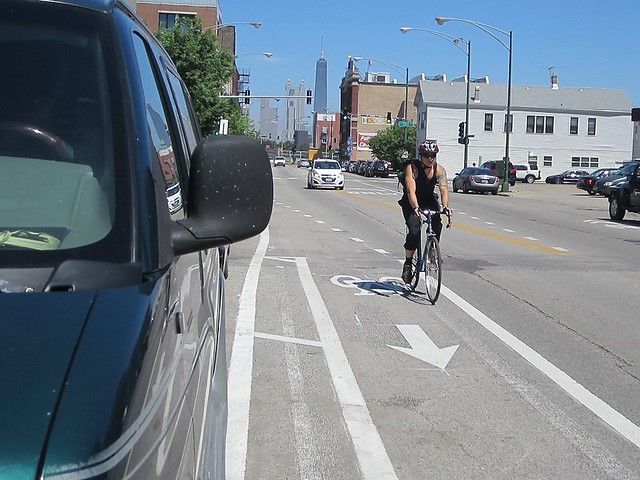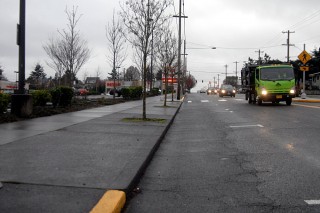As the City of Portland continues public meetings with its two massive parking reform committees, most attention has been on parking prices: how much permits and meters should cost and how the money should be spent.
But another issue has, so far, mostly escaped notice: The many ways that parking spaces can conflict with biking improvements.
“We need to make it easier to repurpose parking lanes for safer bicycle facilities,” Bicycle Transportation Alliance Advocacy Director Gerik Kransky, who sits on the city’s “centers and corridors” task force about neighborhood parking, shared with us on Wednesday. “That’s why I’m there.”
But like many biking supporters on the committees — and there are quite a few — Kransky says he’s not quite sure how that would happen or exactly what biking advocates should ask for.
“We need to make it easier to repurpose parking lanes for safer bicycle facilities, but the mechanisms by which we get there, I don’t know.”
— Gerik Kransky, BTA
“It is very provocative and I don’t think it’s been done,” said Owen Ronchelli of Go Lloyd, a group with a mission to “create a thriving environment for business” in the Lloyd District in part by improving non-car transportation options.
Though Portland has often removed travel lanes in order to add bike lanes, it’s never removed a parking lane from a commercial corridor for the sake of bike facilities — something that’s happened in Austin, Seattle, Chicago and San Francisco, among other places.
Mauricio LeClerc, the city’s lead staffer on its downtown parking task force, said he wasn’t aware of any existing tools that could help engineers and planners weigh the citywide interest in bike facilities against a commercial district’s interest in auto parking.
So we contacted various people inside and outside of Portland to come up with a possible list of ideas for an auto parking policy that would, in addition to letting neighborhoods set a fair price for parking, allow for the city to improve biking, too.
City staffers would get guidance on how to compare the value of parking spots to the value of bike lanes

unused, but the city recently rejected a proposal to
add buffers or bollards to the 4.5-foot bike lane.
(Photo: J.Maus/BikePortland)
This concept comes from LeClerc, who noted that just as some parking spaces are more valuable than others, some bike lanes are more valuable than others. The city currently has no formal way to assess that.
“The city clearly needs some guidance on how to prioritize parking in relation to the ‘green transportation hierarchy,'” said Ted Labbe of Depave, a neighborhood task force member. “Is parking for the various transportation modes part of this hierarchy or is it something separate?”
Brock Howell, policy affairs manager for the Cascade Bicycle Club in Seattle, suggested applying a principle from water law: “use it or lose it.” If a parking space is full less than some percentage of the time, it might be eligible for removal.
Jay Crossley, a researcher at Houston Tomorrow, said his “dream scenario” would be for this to be part of a “multimodal level of service” calculation. (Portland has been quietly working on an MMLOS policy for two years, delaying it more than once.)
“If businesses rely heavily on street parking, they should have to subsidize it,” said Steve Bozzone, who represents the Community Alliance of Tenants on the downtown parking task force. “Streets should be primarily about mobility.”
Advertisement
The city would enforce rules preserving lines of sight near street corners
This concept comes from Mary Kyle McCurdy, policy director for 1000 Friends of Oregon, and sustainability consultant Rex Burkholder. Burkholder called out truck loading zones near corners as a specific issue for improvement and suggested removing parking within 20 feet of every corner. McCurdy suggested maximum height limits.
The city would preserve more curbside spaces for loading and unloading so trucks don’t park in bike lanes
When we interviewed business owners on 28th Avenue about the possibility of removing parking from their street, several were more concerned about the loss of temporary truck parking than of customer auto parking.
“Commercial loading and unloading, especially in our neighborhood business districts, is super important and something I haven’t seen the city put as a priority as it should be,” said Kathryn Doherty-Chapman, a parking task force member who worked on San Francisco’s recent variable-price parking reform.
McCurdy, of 1000 Friends, suggested designating non-bikeway side streets as de facto loading areas in order to reduce double-parking on primary corridors.
Houses wouldn’t need full garages and driveways if they have an on-site bike shed
As we wrote this month, every single-family home in Portland more than 500 feet from a frequent transit line is required to have room for two on-site auto parking spaces — this in a city where hundreds of homeowners build structures to store their bikes.
That’s an idea from Bozzone; so is the next.
The city would add bike corrals when bike parking runs out
Ever since Portland invented the on-street bike corral, 100 percent of them have been requested by nearby businesses. Bozzone said it might be time for this to change.
“The city should not need a business owner’s permission to install bike racks/corrals if there is clear demand for it,” he wrote. “Right now a biz can say no and maintain the status quo, even if 100 of us request a rack.”
Door-zone warning markings would be a standard feature of curbside parking spaces on busy streets

When door-zone bike lanes don’t have marked buffers, more than 90 percent of people bike in the door zone. With buffers, this falls to 60 percent.
Though door-zone bike lanes are sometimes referred to as “bike-lane protected parking,” Portland continues to create them, and it obviously has many streets with no bike lanes where bike users feel pressured to ride in the door zone so cars can pass them. With or without a bike lane, there’s no reason that the city’s standard paint requirements for every on-street parking space couldn’t include a marked door zone.
The city would put the same burden on creating new parking spaces as it does on removing them

spots next to a Fred Meyer parking lot.
(Photo: M.Andersen/BikePortland)
Last year, less than six months after retreating from a bruising attempt to persuade local businesses and landlords to support auto parking removal on one side of NE 28th Avenue in order to make a crucial northbound biking connection comfortable, the city created dozens of newly permanent street parking spaces on East Burnside, right around the corner in the very same district.
The city’s Bike Plan for 2030 calls for both Burnside and 28th to have “separated in-roadway” bike facilities. According to Metro’s Active Transportation Plan, an all-ages bikeway on Burnside would have the highest return on investment of any bike project on Portland’s east side.
Transit consultant Jarrett Walker once wrote that each of Europe’s human-friendly streets, cleared of auto parking and travel lanes amid huge political battles over the last 40 years, could be seen as a “battlefield memorial recording a triumph that involved major pain and suffering.” A bike-friendly parking policy would at least prevent Portland from creating future battlefields for itself.
Correction 9:40 pm: An earlier version of this post failed to mention the lower parking requirement for single-family homes within 500 feet of frequent bus lines.





